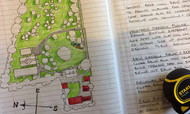2020 Quickcrop Garden Plan
Like you, I am itching to get outside and can't wait for the season to get started. This year I will be spending more time in the garden as my output of video and photos was pretty weedy last year, I intend to correct this in 2020. As usual I will be posting news from the vegetable garden but this year I will also be covering flowering plants and garden design as I further develop my site.
For the last few years I have been documenting my fruit and vegetable growing but as I am now starting to work on other areas of my garden I figured I might as well include these as well. I have a few projects planned which may provide some useful information including planting a steep bank, planting under trees and planting a wildflower meadow. I will also be continuing to develop the field in front of my house by adding more trees but including ferns, grasses and flowering plants to create a natural woodland look.
I have a few different soil types on my site including free draining neutral soil, heavy clay and some very acidic black peat so hopefully they will throw up some interesting challenges. One of my first tasks this year is coming up with a plan for the peat area as it is the largest blank canvas (the 2 acre field) and I need to get the larger, structural plants going as anchor points in an otherwise open space.

The photo above shows new green leaves beginning to open on hydrangea cuttings kindly taken for me by my Mother in 2018 - thank you! (she sometimes reads this). The cuttings are a mix of purples, blues and whites and include lace cap and mop head flowers but I have no idea which is which. Like fruit bushes, hydrangeas produce flowers on last years growth so there were no flowers last year, I will need to pot them on again this season so I can label the flower types.
As you probably know the colour of hydrangea blooms differ depending on the soil type. Alkaline soil will produce pink flowers (which I don't particularly like) while acidic soil will produce the beautiful blue and purple heads I am after. I am using ericaceous (acid) compost in the pots which will give me an idea of the colour of the flowers but won't be completely accurate as the pH of my soil may be lower or higher than the compost in the pots, we'll see what happens.

My acidic, peaty soil is clearly the place for my hydrangeas (purple lace caps pictured above); the other obvious choice would be rhododendrons, azalias or camelias but while I agree their blooms are stunning I am not crazy about their dark, glossy leaves which can look a bit solid in a 'wild' setting. Inspired by roadside displays of wildflowers in the West of Ireland (also acid soil) I am aiming for something similar with a mix of wildflowers, grasses and ferns, it should be light and airy so I want to avoid plants with a lot of dark mass.
I am a fan of crocosmia/montbretia (also pictured above) and have always loved the orange flowers which look fantastic against the blues and purples of the hydrangeas. I was, however ,talking to my secret garden angel yesterday who made the point that while crocosmia is seen all over the West coast, it is a South African plant and therefore not native (I pretended I knew this but I didn't). She also urged caution when considering this vigourous grower as it can quickly crowd out other plants and can be considered invasive.

I do have a some enclosed areas where I think it can be kept in check (a narrow strip of soil between a wall and my lane) so hopefully it can be part of the mix. If you are interested you can follow this journey on our blog where I will be posting more detailed information on what I'm up to while giving you the quick 123 in our weekly newsletter.
That is about it for this week. Next week we are back in the vegetable garden and will be starting to sow broad beans in pots and generally getting our ducks in a row for the coming season.
See you next week!
Andrew
